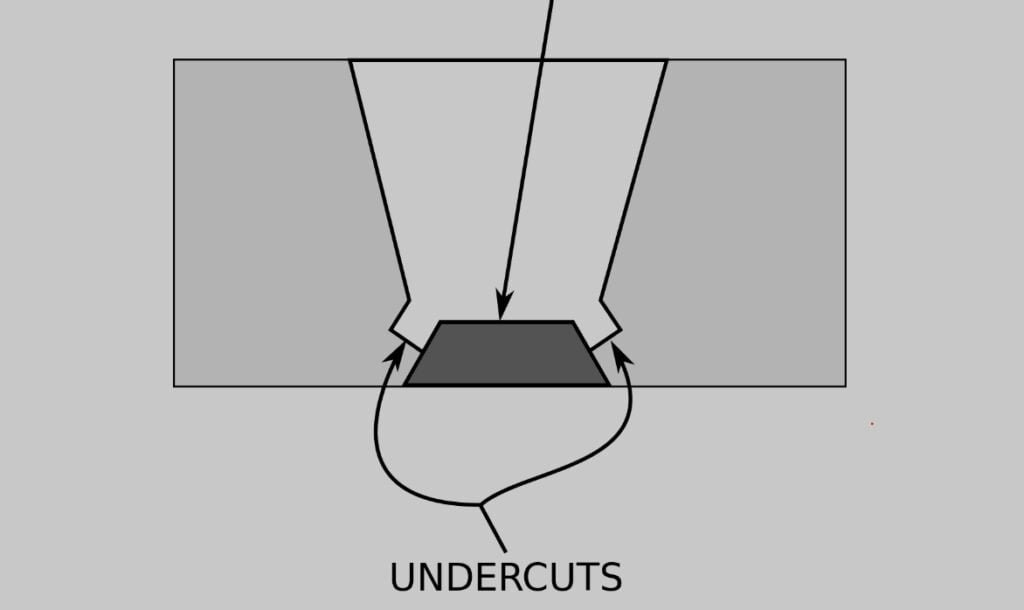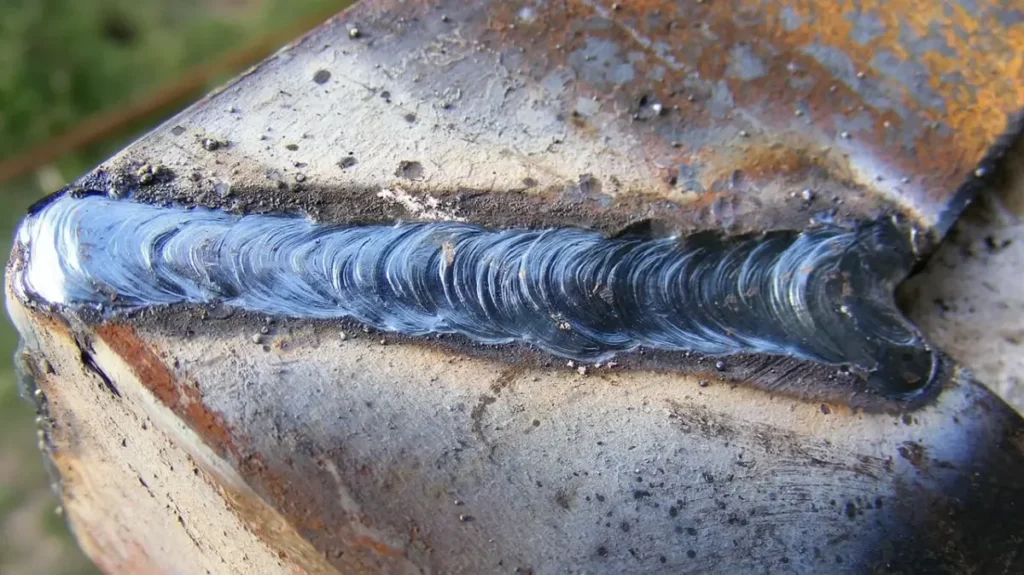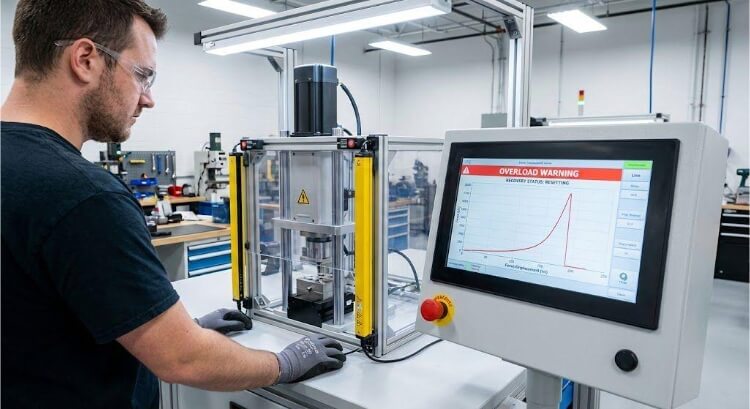The quality of the weld is crucial in professional welding. It ensures durability and safety. One welding defect, which is often unnoticed and destroys the aesthetics and strength of a welding cut, is a common welding defect. This article explores the complexities of welding undercut and explains what it is, why it occurs, and how to prevent it effectively.
Welding undercut: Basics
What is welding undercut?
Definition and Overview
A typical welding defect is the undercut. This occurs when the weld does not adequately cover the base metal. This flaw could significantly weaken structural integrity, making the weld joint more vulnerable to failure.
Types of undercuts in welding
- External Undercut: The undercut is visible as a groove on the surface. This is easier to detect and, therefore, to correct. Its presence indicates a possible welding weakness that requires immediate attention.
- Undercut Internal: This undercut needs to be more evident than the external counterpart. It occurs inside the weld and can be more challenging to detect. This requires sophisticated inspection methods to detect. It is harder to detect but poses a serious risk to the structural integrity of the weld.
It is essential to address undercutting in welding practices.
It is vital to address undercuts to maintain welded components’ structural integrity and durability. Undercuts can cause stress concentrations and crack propagation. They may also lead to the failure of a welded assembly.
Welding Undercut: What are the Causes?
Undercutting is a common but avoidable welding flaw. Several factors can cause it.
- Excessive heat input: When the current or voltage setting is too high, base metal will melt faster than filler metals can fill the void. This results in undercuts at the edges of the weld.
- Improper Electrode Handling: An incorrect electrode angle or an electrode of the wrong size can misdirect the heat, causing uneven distribution and, therefore, undercut.
- Inappropriate Filler Material or Shielding Air: The wrong filler material or shielding gases can lead to disparities in the thermal behavior of the base metals and the weld, which may manifest as undercuts or gaps due to inadequate fusion.
- Faulty Welding Practices: A poor technique or an inappropriate welding speed may prevent the filler material from penetrating the base metal or fusing, causing weaknesses like undercuts.
- Compromise Electrode Integrity: Using an electrode that is dampened or contaminated can cause the arc to destabilize and compromise the purity of the weld pool, increasing the chance of undercuts and other defects.
Understanding and addressing the causes is crucial to ensuring the strength of welded joints. This highlights the importance of precise parameters, correct technique, and the selection of appropriate materials.
The Effects of Weld Integrity on Undercut
Undercutting a weld can hurt its integrity, compromising the strength of the finished product. How undercutting impacts weld strength:
Weaknesses in the Structure
The undercut creates a notch at the edge of the weld. This reduces the area of material that can support the load. This reduces the structural strength of a weld and makes it less able to resist operational stress.
Stress Concentration Points
Undercuts can act as stress concentrators in materials. They amplify stress above what we usually expect. This is especially problematic for applications subject to vibrations or cyclic loads since it can cause premature failure of the weld component.
Crack Initiation: Potential Benefits
Undercuts not only weaken the weld but also provide a site that is conducive to crack formation. Undercut cracks can spread under the influence of operational stress, leading to structural failure. This risk is particularly concerning for critical applications, where failure could have catastrophic consequences.

Identification and Prevention of Welding Undercut
Undercutting Signs and Symptoms
Shengen is committed to ensuring that our welds are of the highest quality. Identifying undercut signs as early as possible in the production process is essential. This will help us maintain our high standards. Here’s our approach to identifying undercut:
Visual Inspection Techniques
Visual inspection is the easiest and fastest way to detect undercut. Our inspectors undergo training to spot irregularities in the weld seam. They focus on grooves and notches, which could indicate undercutting. This method works well for external undercuts visible to the naked eye. Inspectors can assess weld quality accurately by using appropriate lighting and magnifying tools.
Use of Non-Destructive Test (NDT Methods)
We use non-destructive methods (NDT) to conduct a comprehensive inspection. We can examine the internal structure without damaging components using radiographic testing, magnetic particle inspection, and ultrasonic testing. These methods deepen our understanding of the weld. They uncover issues invisible to visual inspection.
Preventing an Undercut Weld
We adjust welding parameters and techniques to prevent undercuts during welding. Here are some tips to improve your welding and prevent undercut defects.
- Optimal Voltage and Current Settings: Finding the sweet spot is essential. The goal is to find the right balance between heat and spattering. A welding chart or calculator will help you determine the correct material and thickness settings.
- Precise Angle and Size of the Electrode: The angle of the electrode should allow for a uniform heat distribution across the bead. Most commonly, welders use 90-degree angles for horizontal or flat welding. They use 45-degree angles for vertical runs and a slight 5-15-degree tilt for overhead applications. It is also essential to match the electrode size with the thickness of the base metal and the joint design. A finer electrode will produce a smaller pool of weld and a more focused arc, reducing the risk of an undercut.
- Selecting the Right Filler Metal: By selecting a filler with properties similar to that of the base metal (tensile strength, malleability, and thermal expansion), you can reduce cracking and warping caused by thermal stress. Shielding gases must be selected carefully to protect the weld pool from contamination and oxidation. The options range from argon, helium, or carbon dioxide for non-ferrous materials, oxygen or carbon dioxide for carbon steels, to a mixture of argon, carbon dioxide, and oxygen for stainless steels.
- Improved Welding Technique and Pace: It is essential to refine your welding techniques to obtain smooth, consistent weld beads. You can maintain an even heat output by minimizing electrode weaving and oscillation. This will prevent undercutting. The welding speed should align with the filler metal deposition rate and base metal melting. Over-melting can occur if the welding pace is too slow, while a fast pace could compromise penetration or fusion.
- Maintenance: It is essential to keep electrodes clean and dry. To avoid moisture that can cause porosity, hydrogen embrittlement, and arc instabilities, store them in dry conditions or use a dryer. Cleaning the electrodes before welding to remove contaminants will ensure a pure weld pool.
You can reduce the number of defects caused by undercutting your welds while improving the efficiency and quality of the process.

Welding Undercut Repair and Remediation
Assessing the severity of undercuts
Shengen’s approach to quality assurance includes preventing defects such as undercuts and managing them effectively when they occur. The first step is to assess the severity of the undercut accurately. This will inform our decisions about necessary repairs.
Repair Criteria
When deciding to repair an undercut, several factors come into play. These include the depth and size of the undercut and its location. We evaluate the undercut to see if it prevents the weld from meeting design specifications and standards. We also consider aesthetics, fatigue life, and the load-bearing capability of the weld when determining whether a repair is needed.
Impact Assessment of Structural Integrity
Undercuts can reduce the material’s cross-sectional surface area, affecting its strength and resistance to operational stress. When assessing an undercut’s severity, we consider its potential to cause cracks or propagate existing flaws. This assessment includes a thorough analysis of the operational environment for the welded structure, which may include factors such as dynamic loads, temperature fluctuations, and exposures to corrosive materials.
Techniques for Repairing Undercut
Shengen applies specialized techniques if the undercut needs repair. These are some of the leading strategies and techniques that we employ:
Weld Repair Techniques
- Rewelding: Grinding down the area of the undercut is often the first step in many repair processes. This will create a uniform, clean surface free from defects. This preparation is essential for a strong reweld that’s free of defects. After grinding the area, it is rewelded carefully, adhering to optimized welding parameters to avoid reintroducing undercuts or other defects.
- Preheating and Post-Weld Heating Treatment (PWHT): For materials that can suffer from stress-related defects, it is essential to preheat before rewelding. These processes reduce residual stresses and cracking risk, giving the repair weld the best chance for success.
Filling and Finishing Techniques
- Filling With Weld Metal: Weldable metal is expected to fill a groove when dealing with it. It is essential to control the welding process precisely to fully integrate the fill metal with the base material and existing weld without causing additional defects.
- Finishing to Improve Structural Integrity: The repair will restore or improve the component’s surface to its original condition. It may be necessary to grind, polish, or machine the area to match the surrounding material structurally and aesthetically.
Quality Control and Assurance
To maintain the integrity and reliability of our products, we must ensure the highest quality of repaired welds. We manage weld repair, quality assurance, and control.
Assuring Quality of Repaired Weld
- Adherence: To Welding Standards All Repair Work Is Performed In Compliance With Recognized Welding Standards.
- Qualified Staff: Only certified and skilled welders can perform repairs, guaranteeing the highest level of expertise.
- Continuous monitoring: Supervisors and quality control experts oversee the repair process. They ensure that all procedures are followed correctly.
Post-repair testing and validation
- Visual inspection: Each repaired weld is subjected to a thorough visual examination to detect defects or irregularities.
- Non-Destructive Testing (NDT): We use various NDT methods to ensure structural integrity.
- Mechanical Test: In some cases, mechanical testing, such as tensile and bend tests, is conducted to validate the performance of the repaired welding under simulated service circumstances.
Conclusion
Our journey at Shengen through the challenges of welding undercut and the solutions we have found reflect our unwavering commitment to excellence in sheet metal fabrication. Our approach includes a comprehensive, multi-faceted approach rooted in our commitment to quality and reliability. We identify the causes of welding undercuts and then implement advanced technologies to prevent and repair them.
Do you need a reliable sheet metal parts manufacturer? Shengen is the place to go. We specialize in sheet metal laser cutting, bending, surface finish, and sheet metal welding. Reach out to Shengen Today and seek help from professionals!
FAQs:
How much undercut can be allowed in welding?
The amount of undercut allowed in a particular weld depends upon the standards and specifications of the project. Undercuts greater than 0.5mm in most structural applications are considered unacceptable. However, this can be subject to change depending on the requirements of the regulatory body and the engineering requirements.
Is it possible to eliminate the risk of welding undercut?
Eliminating the risk of welding undercut is challenging. However, we can significantly reduce it with good technique, proper equipment settings, and following best practices. To minimize the risk of undercutting, you must have a continuous training program, use advanced technologies, and focus on quality. It is essential to reduce and manage this risk.
What are the effects of a welding undercut not treated on a structure over time?
An untreated welding undercut can damage an item’s structural integrity over time. This can result in reduced load-bearing capability, increased stress concentration, and crack initiation.
Is there a specific welding process more likely to cause undercutting than others?
Specific welding processes can be more susceptible to undercutting due mainly to the heat input or metal transfer mechanism. Both Gas Metal Arc Welding and Shielded Metal Arc Welding tend to be more susceptible to undercutting. This is especially true if not adequately controlled. Gas Tungsten Arc Welding, on the other hand, offers more precise heat control and reduces the likelihood of undercutting.
More Resources:
Welding Standards – Source: ESAB
Welding Defects Guide – Source: Shengenfab
Non-Destructive Testing – Source: Wikipedia
Welding shielding gas selection guide – Source: Lindedirect
Hey, I'm Kevin Lee

For the past 10 years, I’ve been immersed in various forms of sheet metal fabrication, sharing cool insights here from my experiences across diverse workshops.
Get in touch

Kevin Lee
I have over ten years of professional experience in sheet metal fabrication, specializing in laser cutting, bending, welding, and surface treatment techniques. As the Technical Director at Shengen, I am committed to solving complex manufacturing challenges and driving innovation and quality in each project.




